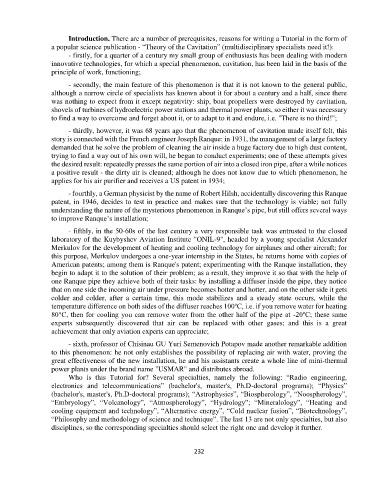Page 233 - Теория кавитации
P. 233
Introduction. There are a number of prerequisites, reasons for writing a Tutorial in the form of
a popular science publication - “Theory of the Cavitation” (multidisciplinary specialists need it!):
- firstly, for a quarter of a century my small group of enthusiasts has been dealing with modern
innovative technologies, for which a special phenomenon, cavitation, has been laid in the basis of the
principle of work, functioning;
- secondly, the main feature of this phenomenon is that it is not known to the general public,
although a narrow circle of specialists has known about it for about a century and a half, since there
was nothing to expect from it except negativity: ship, boat propellers were destroyed by cavitation,
shovels of turbines of hydroelectric power stations and thermal power plants, so either it was necessary
to find a way to overcome and forget about it, or to adapt to it and endure, i.e. "There is no third!";
- thirdly, however, it was 68 years ago that the phenomenon of cavitation made itself felt, this
story is connected with the French engineer Joseph Ranque: in 1931, the management of a large factory
demanded that he solve the problem of cleaning the air inside a huge factory due to high dust content,
trying to find a way out of his own will, he began to conduct experiments; one of these attempts gives
the desired result: repeatedly presses the same portion of air into a closed iron pipe, after a while notices
a positive result - the dirty air is cleaned; although he does not know due to which phenomenon, he
applies for his air purifier and receives a US patent in 1934;
- fourthly, a German physicist by the name of Robert Hilsh, accidentally discovering this Ranque
patent, in 1946, decides to test in practice and makes sure that the technology is viable; not fully
understanding the nature of the mysterious phenomenon in Ranque’s pipe, but still offers several ways
to improve Ranque’s installation;
- fifthly, in the 50-60s of the last century a very responsible task was entrusted to the closed
laboratory of the Kuybyshev Aviation Institute "ONIL-9", headed by a young specialist Alexander
Merkulov for the development of heating and cooling technology for airplanes and other aircraft; for
this purpose, Merkulov undergoes a one-year internship in the States, he returns home with copies of
American patents; among them is Ranque's patent; experimenting with the Ranque installation, they
begin to adapt it to the solution of their problem; as a result, they improve it so that with the help of
one Ranque pipe they achieve both of their tasks: by installing a diffuser inside the pipe, they notice
that on one side the incoming air under pressure becomes hotter and hotter, and on the other side it gets
colder and colder, after a certain time, this mode stabilizes and a steady state occurs, while the
temperature difference on both sides of the diffuser reaches 100ºC, i.e. if you remove water for heating
80°C, then for cooling you can remove water from the other half of the pipe at -20ºC; these same
experts subsequently discovered that air can be replaced with other gases; and this is a great
achievement that only aviation experts can appreciate;
- sixth, professor of Chisinau GU Yuri Semenovich Potapov made another remarkable addition
to this phenomenon: he not only establishes the possibility of replacing air with water, proving the
great effectiveness of the new installation, he and his assistants create a whole line of mini-thermal
power plants under the brand name "USMAR" and distributes abroad.
Who is this Tutorial for? Several specialties, namely the following: “Radio engineering,
electronics and telecommunications” (bachelor's, master's, Ph.D-doctoral programs); “Physics”
(bachelor's, master's, Ph.D-doctoral programs); “Astrophysics”, “Biospherology”, “Noospherology”,
“Embryology”, “Volcanology”, “Atmospherology”, “Hydrology”; “Mineralology”, “Heating and
cooling equipment and technology”, “Alternative energy”, “Cold nuclear fusion”, “Biotechnology”,
“Philosophy and methodology of science and technique”. The last 13 are not only specialties, but also
disciplines, so the corresponding specialties should select the right one and develop it further.
232

